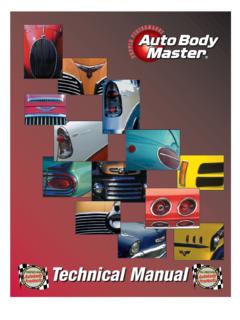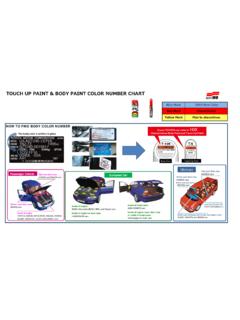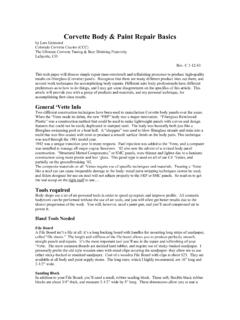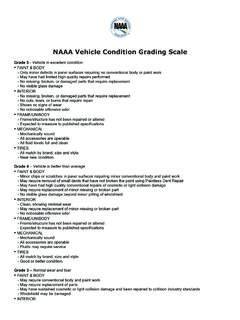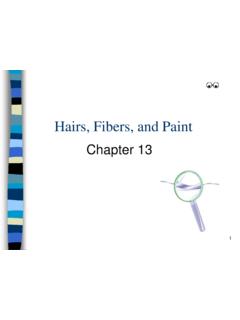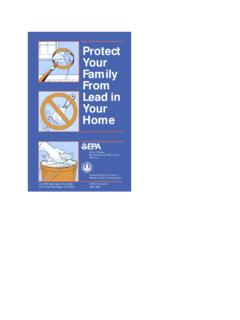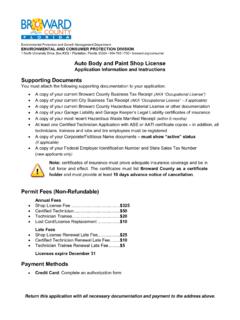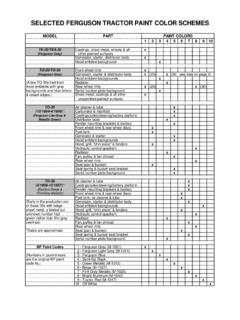Transcription of ABM Sandpaper Guide - Professional Automotive Paint …
1 Sandpaper Product Guide Premium Automotive Aftermarket Quality Complete Selection of Hand &. Power Sanding Accessories Excellent Value Index Introduction to Abrasives Abrasive Components .. 3. Sandpaper Application Chart .. 4. Package 5-1/2" x 9" Sandpaper Waterproof .. 7. Gold Anti-clog .. 7. Non-woven pads .. 7. Gold Stick-on Sanding Discs 6" Gold Anti-clog 6 pack .. 8. 6" Gold Anti-clog 25 pack .. 8. 5" Gold Anti-clog 25 pack .. 8. Body File Strips / Aluminum Oxide Body File Strips PSA .. 9. 9" x 11" Aluminum Oxide Sheets .. 9. 3-2/3" x 9" Aluminum Oxide .. 9. Grinding Discs / Miscellaneous Resin Fiber Discs .. 10. Cut-off Wheels .. 10. Sanding Sponges.
2 10. Rubber Sanding Block .. 10. DA Sanding Pad .. 10. Sandpaper Display 4 Foot Sandpaper Display .. 11. 2. About AutoBody Master Sandpaper Below is a brief description of the components that go into producing high quality coated abrasives. The AutoBody Master Brand Sandpaper is made using premium raw materials for high performance and durability. All of these products are well suited for commercial and industrial applications. Manufacturing coated abrasives employs the use of two coating operations to bond the abrasives to the paper or cloth. For some products, a stearate coating is added so that the abrasive will cut cooler and last longer. Make Coat (the 1st application) is a base coat used as a primary bond between the grit and the paper or cloth.
3 Size Coat (the secondary application) is the top coat applied to fill in around the grit and secure the grain to the backing. Stearate Coat (oversize coat) special zinc stearate coating maximizes resistance to clogging and loading and allows the abrasive to cut cooler. Grit Aluminum Oxide (A/O) - A man-made synthetic material which has good overall properties for use in a wide range of abrasive applications. Preferred for power tool sanding because of its durability. Silicon Carbide (S/C) - A man-made synthetic grain which is very sharp. Preferred for Automotive Paint preparation and is well suited for wet or dry sanding. Backing Paper A-wt - Light-weight paper used only on very fine grits.
4 Hand sanding only. B-wt - Light-weight paper for wet or dry sanding. Hand sanding only. C-wt - Medium-weight paper for sheets and discs. Hand and power sanding. D-wt - Medium-weight paper for sheets and discs. Hand and power sanding. F-wt - Heavy-weight paper for discs and belts. Power sanding only Bond Glue - Low strength water-based adhesive. Urea Resin - Medium strength urea-based adhesive. Phenolic Resin - High strength phenolic-based adhesive. Epoxy Resin - High strength solvent-based phenolic waterproof adhesive. 3. Sandpaper Application Chart Automotive Refinishing There are many different products that make up the offering of abrasives used in the body shops around the world.
5 The professionals that work in this field have their own procedure to handle the types of repair projects that come into their shops. The following list includes common Automotive repair jobs and the abrasives that are typically used from the beginning to the end of the project. Helpful Tools Equipment like dual action sanders, drills and body file boards can aid in acheiving excellent results with less physical energy. However, hand sanding is commonly used throughout these processes. Sanding blocks are commonly recommended to achieve consistent results and keep scratches to a minimum. Repairing Scratches, Stone Chips and other minor imperfections Once the area has been cleaned, the sanding process begins: Feather edge the defect (scratch).
6 There are a number of products that can be used. 5" or 6" PSA Gold Discs 180-400 grit; 5-1/2" x 9" anti-clog 220-320; 5- 1/2" x 9" waterproof 220-400. Finish the feather edging process with the closest grit of Sandpaper that your primer recommends. The next step is to prime the area being repaired: Apply primer slightly beyond the feather edge area and higher than the surrounding areas. Level the surface with Waterproof 320-400 grit;. Sanding Sponges - Fine; clean up with Maroon non-woven finishing pad. Repeat the process if necessary. Finsh sand the area with the closest grit of Sandpaper that your color recommends. The vehicle is now ready to be painted.
7 After painting, sanding with ultra fine grits and using various compounds and polishes can remove defects and flatten the surface, producing a finer finish. The final sanding of the vehicle should be done using 5-1/2" x 9" waterproof 1000-1500 grit for finesse sanding of surface imperfections in enamels, acrylics or clear coats. 5-1/2" x 9" waterproof sheets are available up to 2000 grit. Fixing deep rust spots Remove the rust. This major problem is very common for the body shop to deal with and abrasives play a significant role in restoration. Grind the area down to the base metal around the affected areas, removing the rust. Once you start to see shiny metal, stop.
8 5" and 6" PSA Gold discs - 40 grit; Resin Fiber Discs 36-50 grit;. Body File Strips 36 or 40 grit are used to give fast aggressive cutting action. 4. Sandpaper Application Chart If the rust or grinding action has created a hole in the sheet metal, often, a piece of mesh/screen or metal is used to help bridge the hole. After this has been secured to the vehicle, use body filler to rebuild the damaged area. Reshape with Body File Strips 40-80-180 grit; 5-1/2" x 9" anti-clog 80-120-180 grit; 5" or 6". PSA Gold discs 80-120-180; Sanding Sponges Medium-Fine. For the best results, sand in stepped progression to blend and level the body filler to the original suface shape.
9 Feather edge with the medium and fine grit papers to prepare for priming. The next step is to prime the area being repaired: Apply primer slightly beyond the repair area and higher than the surrounding areas. Level the surface with Waterproof 320-400 grit;. Sanding Sponges - Fine. Repeat the process if necessary. Finsh sand the area with the closest grit of Sandpaper that your color recommends. The vehicle is now ready to be painted. After painting, sanding with ultra fine grits and using various compounds and polishes can remove defects and flatten the surface, producing a better looking finish. The final sanding of the vehicle should be done using 5-1/2" x 9" waterproof 1000-1500 grit for finesse sanding of surface imperfections in enamels, acrylics or clear coats.
10 5-1/2" x 9" waterproof sheets are available up to 2000 grit. Repairing Dents After the dents have been hammered out, the Paint must be removed down to the bare metal. Use 5" and 6" PSA Gold discs - 40 grit; Resin Fiber Discs 36-50 grit; Body File Strips 36-40 grit. Body filler is used to fill in the dented area on the vehicle. Sand with Body File Strips 40-80-180 grit; 5-1/2" x 9". Anti-clog 80-120-180 grit; 5" or 6" PSA Gold discs 80-120-180; Sanding Sponges Medium-Fine; For the best results, once again sand in progression to blend and level the body filler. Feather edge with the medium and fine grit papers to prepare for priming. 5. Sandpaper Application Chart The next step is to prime the area being repaired: Apply primer slightly beyond the repair area and higher than the surrounding areas.
